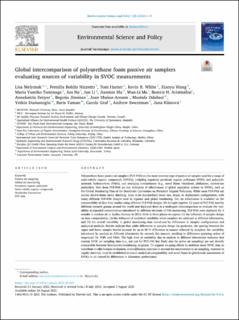Global intercomparison of polyurethane foam passive air samplers evaluating sources of variability in SVOC measurements
Melymuk, Lisa; Bohlin-Nizzetto, Pernilla; Harner, Tom; White, Kevin B.; Wang, Xianyu; Tominaga, Maria Yumiko; He, Jun; Li, Jun; Ma, Jianmin; Ma, Wan-Lin; Aristizábal, Beatriz H.; Dreyer, Annekatrin; Jiménez, Begoña; Muñoz-Arnanz, Juan; Odabasi, Mustafa; Dumanoglu, Yetikin; Yaman, Baris; Graf, Carola; Sweetman, Andrew; Klánova, Jana
Peer reviewed, Journal article
Published version
Permanent lenke
https://hdl.handle.net/11250/2830907Utgivelsesdato
2021Metadata
Vis full innførselSamlinger
- Publikasjoner fra Cristin - NILU [1377]
- Vitenskapelige publikasjoner [1112]
Sammendrag
Polyurethane foam passive air samplers (PUF-PAS) are the most common type of passive air sampler used for a range of semi-volatile organic compounds (SVOCs), including regulated persistent organic pollutants (POPs) and polycyclic aromatic hydrocarbons (PAHs), and emerging contaminants (e.g., novel flame retardants, phthalates, current-use pesticides). Data from PUF-PAS are key indicators of effectiveness of global regulatory actions on SVOCs, such as the Global Monitoring Plan of the Stockholm Convention on Persistent Organic Pollutants. While most PUF-PAS use similar double-dome metal shielding, there is no standardized dome size, shape, or deployment configuration, with many different PUF-PAS designs used in regional and global monitoring. Yet, no information is available on the comparability of data from studies using different PUF-PAS designs. We brought together 12 types of PUF-PAS used by different research groups around the world and deployed them in a multi-part intercomparison to evaluate the variability in reported concentrations introduced by different elements of PAS monitoring. PUF-PAS were deployed for 3 months in outdoor air in Kjeller, Norway in 2015–2016 in three phases to capture (1) the influence of sampler design on data comparability, (2) the influence of analytical variability when samplers are analyzed at different laboratories, and (3) the overall variability in global monitoring data introduced by differences in sampler configurations and analytical methods. Results indicate that while differences in sampler design (in particular, the spacing between the upper and lower sampler bowls) account for up to 50 % differences in masses collected by samplers, the variability introduced by analysis in different laboratories far exceeds this amount, resulting in differences spanning orders of magnitude for POPs and PAHs. The high level of variability due to analysis in different laboratories indicates that current SVOC air sampling data (i.e., not just for PUF-PAS but likely also for active air sampling) are not directly comparable between laboratories/monitoring programs. To support on-going efforts to mobilize more SVOC data to contribute to effectiveness evaluation, intercalibration exercises to account for uncertainties in air sampling, repeated at regular intervals, must be established to ensure analytical comparability and avoid biases in global-scale assessments of SVOCs in air caused by differences in laboratory performance.

